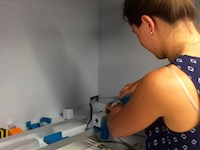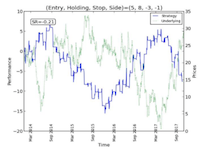 Daniel Byrnes '15
Daniel Byrnes '15
Extreme Value Theory and Backtest Overfitting in Finance
Advisor: Thomas Pietraho
Using tools from extreme value theory, Daniel proposed a new statistic, the minimum back test length at level p, to determine whether a multi-parameter investment strategy has the potential to be overfit and its future returns may be poorly predicted by its performance on historical market backtest data.
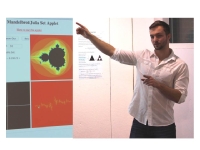 Maxwell Wolf '15
Maxwell Wolf '15
Independent Summer Study: Exploring Chaos Theory Through Art
Advisor: Michael King
Max studied Chaos Theory, with the goal to tie together both his major in mathematics and his minor in visual arts. Chaos modeling describes non-linear dynamic systems like weather systems and turbulence in liquids and gasses, and creates incredibly intricate images of fractals. Max's studies culminated in a campus-wide exhibit at the Main Gallery in the Edwards Center for Art and Dance where he demonstrated the beauty of chaos while simultaneously defining, explaining, and attempting to teach the mathematical complexity of the theory to the gallery viewers. Max says this project allowed him to explore and appreciate how math and art intersect and illuminate each other.
Andrew Pryhuber ’15 (Kibbe Institutional Research Fellowship)
Summer Research 2014 and Honors Project: The Structure and Unitary Representations of SU(2,1)
Advisor: William Barker
The long term goal of this project was to determine the image of the Lp-Schwartz space (0 < p 2) under the operator-valued Fourier transform on the semi-simple Lie group SU(2,1). This would extend research conducted in the 1980s for the Lie group SL(2,R). However, the dimension of SL(2,R) is three while the dimension of SU(2,1) is eight, making the analysis of SU(2,1) both more difficult and more interesting than SL(2,R). Andrew worked in a partnership with Justin Dury-Agri during the summer of 2014 and into that fall. Together they worked out the needed structural apparatus for SU(2,1) (e.g., the root space decomposition). They also mastered some intricate infinite dimensional representation theory, in particular the basics of the “principal series representations” and the “discrete series representations” for SU(2,1). These are of critical importance for even describing the operator-valued Fourier transform on the Lp-Schwartz space of SU(2,1) and its conjectured image space. To fully determine this image requires proving that the transform map is a continuous bijection with a continuous inverse, not a trivial undertaking. Andrew continued to pursue various parts of this program as an Honors project until time ran out. His Honors thesis describes the results of his project.
Justin Dury-Agri ’15 (Surdna Foundation Research Fellowship)
Summer Research 2014 and Independent Study: Lp-Harmonic Analysis on SU(2,1)
Advisor: William Barker
The long term goal of this project was to determine the image of the Lp-Schwartz space (0 < p 2) under the operator-valued Fourier transform on the semi-simple Lie group SU(2,1). This would extend research conducted in the 1980s for the Lie group SL(2,R). However, the dimension of SL(2,R) is three while the dimension of SU(2,1) is eight, making the analysis of SU(2,1) both more difficult and more interesting than SL(2,R). Justin worked in a partnership with Andrew Pryhuber during the summer of 2014 and into that fall. Together they worked out the needed structural apparatus for SU(2,1) (e.g., the root space decomposition). They also mastered some intricate infinite dimensional representation theory, in particular the basics of the “principal series representations” and the “discrete series representations” for SU(2,1). These are of critical importance for even describing the operator-valued Fourier transform on the Lp-Schwartz space of SU(2,1) and its conjectured image space.
Lauren Skerritt '14
Mathematical Modeling of the American Lobster Cardiac Muscle Cell: An Investigation of Calcium Ion Permeability and Force of Contractions
Advisor: Adam B. Levy (with Amy Johnson and Olaf Ellers)
Lauren developed a mathematical diffusion model of the myofibril (muscle cell) to simulate calcium cycling in the lobster cardiac muscle cell. The amplitude and duration of the force curves produced by the model empirically mirrored that of the experimental data over a range of calcium diffusion coefficients (1-16), nerve stimulation durations (1/6-1/3 of a contraction period), and frequencies (40-80 Hz). The characteristics that alter the response of the lobster cardiac muscle system are stimulation duration (i.e., burst duration), burst frequency, and the rate of calcium diffusion into the cell’s cytoplasm. For this reason, she developed protocols that allow parameters representing these characteristics in the calcium-force model to be determined from isolated whole muscle experiments on lobster hearts (Phillips et al., 2004). These parameters are used to predict variability in lobster heart muscle function consistent with data recorded in experiments.
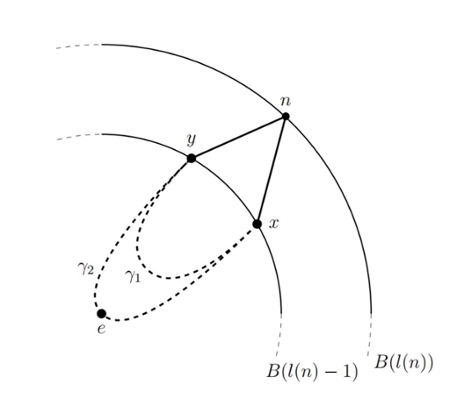 Peter Davids '14
Peter Davids '14
Convexity properties of the Diestel-Leader groups Τ3(2)
(Supported by the NSF through grant DMS-1105407)
Advisor: Jennifer Taback
A mathematical group is a set with an operation satisfying certain basic properties; for example, the integers under addition form a group, as do the real numbers under addition. A Cayley graph is a geometric model of a group -- that is, we hope to view any group much as we think of the real numbers as comprising the number line. This allows us to envision the geometry of a group. We can ask questions about whether spheres in this group geometry are "round" and whether they get larger the way they do in Euclidean space as the radius increases. Almost convexity is a geometric property which tries to answer these questions about the "roundness" of spheres in the geometry associated to a group. In a group which is not almost convex, spheres of larger and larger radii have missing "fingers," quite contrary to our notions of spheres of increasing radii from high school geometry.
In this project, Peter investigated convexity properties for the Diestel-Leader groups, first understanding their geometric model, and then focusing on one example from this family, denoted $\Gamma_3(2)$. The notation means that the geometric model of the group is contained in the product of three regular trees of valence 3. Peter showed that this group is not almost convex, but that it satisfies a weaker convexity condition known as minimal almost convexity.
Sharif Younes '13
NSF-funded Research student: Finite state machines and Thompson’s group F
Advisor: Jennifer Taback
Finite state machines such as finite state automata and pushdown automata are used in computer science to model simple “languages.” In group theory, one often hopes to show that the elements of a group can be described by one of these machines and that such a machine can recognize group multiplication; if so, many computational questions are easily solvable in the group. Such groups are called “automatic” or “context-free” depending on the type of machine used. Sharif is investigating whether Thompson’s group F is “Cayley graph context-free” by constructing pushdown automata recognizing group elements and multiplication. This project lies at the intersection of mathematics and theoretical computer science.
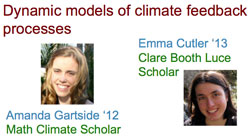
Emma Cutler '13, Amanda Gartside '12, and Carolyn Mayer '13
Clare Boothe Luce Fellow, NSF Math Climate Research Network grantAdvisor: Mary Lou Zeeman
This team works with the Mathematics and Climate Research Network (MCRN) to study dynamical models of paleoclimate. The research goal is to use tools of differential equations and dynamical systems to investigate the feedback effects of different climate processes on each other and on global climate. We are focusing on the interaction between carbon, earth orbitals and ice-albedo feedback in the earth’s glaciation cycles.
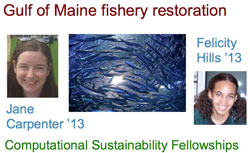 Felicity Hills '13, Jane Carpenter '13, Elena Crosley '13
Felicity Hills '13, Jane Carpenter '13, Elena Crosley '13
Computational Sustainability NSF grant
This team works on the fishery models. The goal is to develop a model that can include the ecological interactions of some key species. This requires adding some age structure to the classic models.
Sharon Ulery '11
Independent Study: Properties of sets of elements in Thompson’s group F
Advisor: Jennifer Taback
This project involved learning about Thompson’s group F, an example of an infinite, finitely generated group. Sharon used the techniques developed by Susanna Kimport as part of her honors project to select large sets of elements of this group, and statistically analyze certain properties of these elements. These sets were not taken randomly, and were used to verify that Kimport’s algorithms ran equally quickly on a variety of types of elements.
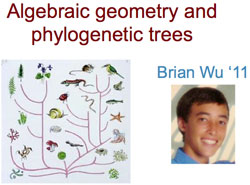 Brian Wu '11
Brian Wu '11
Honors Thesis: Algebraic Geometry
Advised by Thomas Pietraho
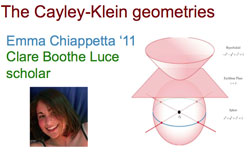 Emma Chiappetta '11
Emma Chiappetta '11
Cayley-Klein Geometries.
Advisor: William Barker
Emma studied the Cayley-Klein geometries from several different viewpoints, most notably those of Jürgen Richter-Gebert and I. M. Yaglom. She read in detail original papers by Klein, Beltrami, and Sommerville, and proved several of her own conjectures about these geometries. She concentrated on the classification of the planar Cayley-Klein geometries as nine subgeometries of the projective plane—subgeometries that include Euclidean hyperbolic, elliptic, Minkowskian, and Galilean. This supports Cayley's famous quote that "Projective geometry is all geometry."
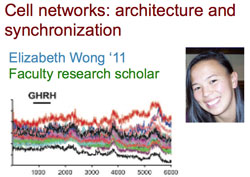 Elizabeth Wong '11
Elizabeth Wong '11
Advisor: Mary Lou Zeeman
Elizabeth modeled networks of cells in the pituitary. Recent experiments in rodents show that each cell type in the pituitary forms a 3-d network of chains, connected by cell clusters. As the animal grows, the cluster-to-chain ratio in the cell network changes. This change in network architecture correlates with a more synchronized release of hormone from the cells. Elizabeth used computational models to investigate whether the change in network architecture can explain the increased synchrony in hormone output.
Christina Argueta '11
Honors Project: Constructing minimal length representatives for elements of Thompson’s group F
Advisor: Jennifer Taback
When studying a finitely generated infinite group described using generators and relations, a natural question is to ask for the minimal number of generators necessary to represent a given group element. Christina studied this problem for Thompson’s group F, building on work of Professor Taback and Micah Miller ’04. Christina was able to give combinatorial conditions governing the creation of these ``minimal length representatives” for many elements of this group. Her results were based on a combination of group theory and insight into the particular group studied, and illustrated the interaction between the varied techniques used to study this group.
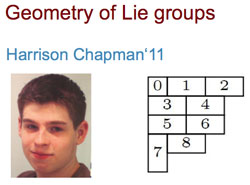 Harrison Chapman '11
Harrison Chapman '11
Honors Thesis: Nilpotent Orbits of Lie Groups
Advised by Thomas Pietraho
Will Richard '11
Independent Study: Folner sets and amenability in Thompson’s group F
Advisor: Jennifer Taback
This project involved studying one of the most famous open questions related to Thompson’s group F, and investigating whether one could produce sets of elements with certain graph-theoretic properties within the Cayley graph of this group. This first involved an understanding of what a Cayley graph of a group is, and how one associates a geometric picture with a particular group. To complete this project, Will studied a variety of techniques developed by research mathematicians to understand the elements of this group and multiplication within the group. These techniques included algebraic, geometric and combinatorial aspects. Some of Will’s numerical estimates relied on counting formulae from combinatorics related to counting binary trees with particular properties. Will also used simulations constructed with the computer program Mathematica as part of his project.
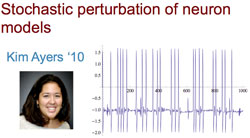 Kim Ayers '10
Kim Ayers '10
Stochastic Perturbations of the Fitzhigh-Nagumo Equations
Advisors: Adam Levy and Mary Lou Zeeman
Kim used stochastic perturbation techniques she learned in a summer research project at Iowa State U. to model the effect of neural noise in the context of the classical Fitzhugh-Nagumo equations for the nerve impulse. The classical equations can capture action potentials and tonic firing of a neuron, but not the more complex patterns of bursting (periods of firing interleaved with periods of quiescence). Kim incorporated stochastic noise into the Fitzhugh-Nagumo equations, representing stochastic opening and closing of ion channels, for example, and showed that the stochastic model was able to exhibit a range of bursting behaviors observed in neurons.
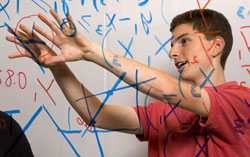 Mark McGranaghan '09
Mark McGranaghan '09
Independent Study) Random selection of elements in Thompson’s group F
Advisor: Jennifer Taback
This project involved formalizing the notion of selecting an element of a group at random. The group used was Thompson’s group F, and a technique to select elements uniformly published in a paper by Elder, Fusy and Reichnitzer was implemented. Mark then used his program to select large sets of random elements and gather statistical data about their “geometric” properties. Every element of Thompson’s group can be represented by a pair of finite rooted binary trees, and some unexpected conclusions were found in statistics about the shape of these trees.
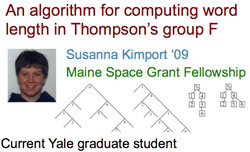 Susanna Kimport '09
Susanna Kimport '09
Honors Project: An algorithm for computing word length in Thompson’s group F
Advisor: Jennifer Taback
This project investigated the feasibility of implementing a computational technique developed by Matt Horak, Melanie Stein and Jennifer Taback for computing word length of elements in Thompson’s group F. After showing that implementing the simplest case of the technique is an NP-complete problem, Kimport developed a practical “smart brute-force” algorithm which computed the correct values very quickly. This project involved a mix of techniques from advanced mathematics, theoretical computer science, and computer
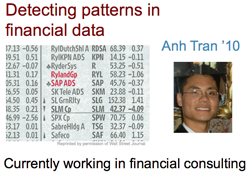 Anh Tran '10
Anh Tran '10
Neural Nets and Finance
Advised by Thomas Pietraho
Erin Taylor '09
Feedback in Lobster Cardiac Oscillations
Advisors: Patsy Dickinson, Adam Levy and Mary Lou Zeeman
Liz Chertavian '09
Inversion of a Firn Air Diffusion Model to Determine Atmospheric Gas Concentration Histories
Advisors: Mark Battle, Adam Levy and Mary Lou Zeeman
As snow falls onto a glacier, it compacts the snow below it slowly until it becomes ice. This glacial snow on top of the ice is called firn. While ice has bubbles of air surrounded entirely by ice, the firn has channels of open air space, called the firn air, that run from the surface of the snow down to the close off region where the snow becomes denser ice. The goal of Liz’s thesis was to improve the mathematical method for determining the atmospheric history of concentrations of greenhouse gases from their current concentrations in the firn air channels. This firn air contains the history for the last 100 years (then the ice cores take over).
Ben Johnson, Network Similarity and Shape Recognition, Fall, 2011.
Advised by Thomas Pietraho
Octavian Neamtu, Generalization of the Landmark Method in Shape Recognition, Fall, 2011.
Advised by Thomas Pietraho
Arsenyi Sheydvasser (Honors Thesis), Advanced Functional Analysis, Fall, 2011.
Advised by Thomas Pietraho
Jonathan Ackerman, Generating Functions and Phylogenetic Trees, Spring, 2011.
Advised by Thomas Pietraho
Sean Wilner (Honors Thesis), Algebraic Geometry, 2010–2011.
Advised by Thomas Pietraho
Leah Wolberg (joint with N. Kieserman), Orbifolds, Spring, 2010.
Advised by Thomas Pietraho
Sean Wilner (joint with N. Kieserman), Orbifolds, Spring, 2010.
Advised by Thomas Pietraho
Mark McGranaghan, Neural Nets and Pattern Recognition, Fall, 2009.
Advised by Thomas Pietraho
Michael Krohn, Financial Mathematics, Spring, 2009.
Advised by Thomas Pietraho
Sarah Landrum, Financial Mathematics, Spring, 2009.
Advised by Thomas Pietraho

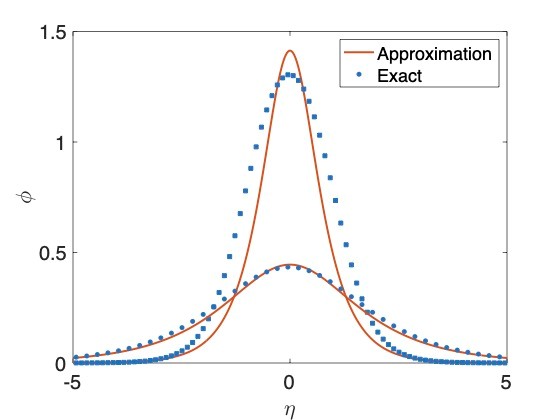
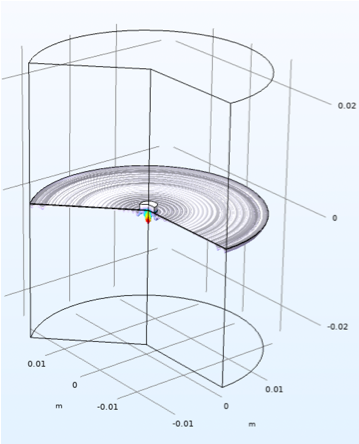



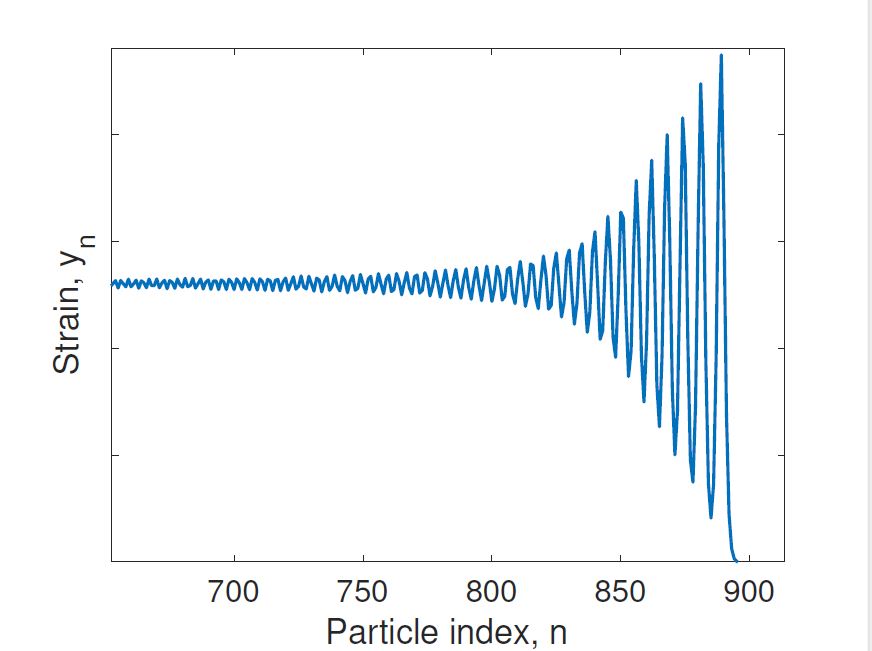
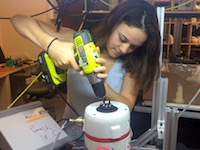
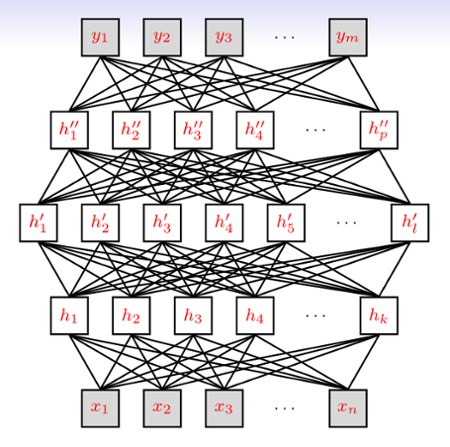 Parikshit Sharma '17
Parikshit Sharma '17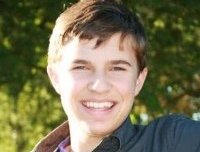 Jacob Hart ’17 and Carina Spiro ’18
Jacob Hart ’17 and Carina Spiro ’18